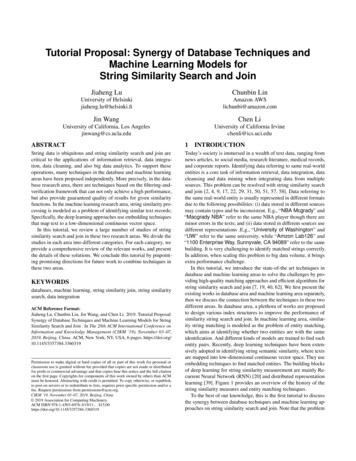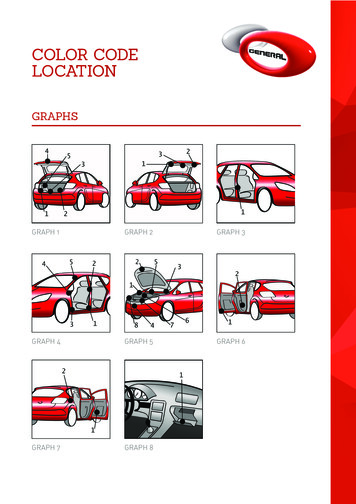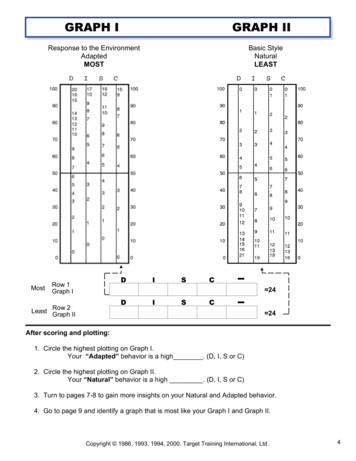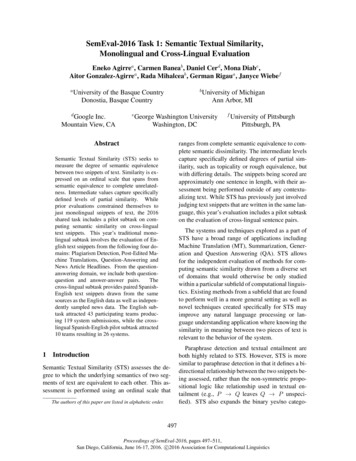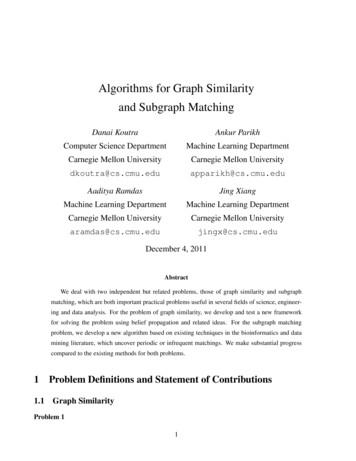
Transcription
Algorithms for Graph Similarityand Subgraph MatchingDanai KoutraAnkur ParikhComputer Science DepartmentMachine Learning DepartmentCarnegie Mellon UniversityCarnegie Mellon itya RamdasJing XiangMachine Learning DepartmentMachine Learning DepartmentCarnegie Mellon UniversityCarnegie Mellon er 4, 2011AbstractWe deal with two independent but related problems, those of graph similarity and subgraphmatching, which are both important practical problems useful in several fields of science, engineering and data analysis. For the problem of graph similarity, we develop and test a new frameworkfor solving the problem using belief propagation and related ideas. For the subgraph matchingproblem, we develop a new algorithm based on existing techniques in the bioinformatics and datamining literature, which uncover periodic or infrequent matchings. We make substantial progresscompared to the existing methods for both problems.11.1Problem Definitions and Statement of ContributionsGraph SimilarityProblem 11
Given: two graphs G1 (n1 , e1 ) and G2 (n2 , e2 ), with possibly different number of nodes and edges, andthe mapping between the graphs’ nodes.Find: (a) an algorithm to calculate the similarity of the two graphs, which returns (b) a measure ofsimilarity (a real number between 0 and 1) that captures intuition well.Innovations: a) We develop a method involving belief propagation, unseen in literature, to solve thisproblem b) The method (and its fast linearized approximate version) gives extremely agreeable resultsc) Except for scalability, we know of no shortcomings of this method.1.2Subgraph MatchingProblem 2Given: a graph time series, where there are T number of graphs.Find: (a) An algorithm to find approximate subgraphs that occur in a subset of the T graphs. (b) Wherethe approximate subgraphs may not occur in the majority of the time points, but in local sectionsof the time seriesInnovations: a) We develop a principled approach to selecting the important time components fromwhich subgraphs should be mined. Our method is also tailored for the problem of selecting subgraphsin biological networks. For this, we use sparse PCA which has not been for this application domain. b)Scalability: Our method is both fast and scalable to real biological data (1000s of nodes). However, ithas not been demonstrated whether it can scale to extremely large networks of more than 10 000 nodes.c) The method gives results that are easy to interpret and biologically sensible.Disclaimer of interests intersecting with course projectAaditya may use the PhoneCall dataset for his DAP. Danai is interested in graph similarity and beliefpropagation for research. Ankur has used tensors for his research, but in a different context. Jing hasused CODENSE before, and is interested in improving it for research purposes. None of the authorshave other course projects this term.The following are the papers read for this course (refer to the numbering in the references section):Jing [21], [28], [22], Ankur [20], [18], [9], Aaditya [5], [26], [27], Danai [10], [14], [15].2
2IntroductionGraphs arise very naturally in many situations - examples vary from the web graph of documents, to asocial network graph of friends, to road-map graphs of cities. Over the last two decades, the field ofgraph mining has grown rapidly, not only because the number and the size of graphs has been growingexponentially (with billions of nodes and edges), but also because we want to extract much more complicated information from our graphs (not just evaluate static properties, but infer structure and makeaccurate predictions). This leads to challenges on several fronts - proposing meaningful metrics tocapture different notions of structure, designing algorithms that can calculate these metrics, and finallyfinding approximations or heuristics to scale with graph size if the original algorithms are too slow. Inthis project, we tackle several of these aspects of two very interesting and important problems, graphsimilarity and subgraph mining, which we broadly introduce and motivate in the next few paragraphs.First, we briefly introduce our two sample datasets (graphs), which will recur throughout this report.2.1DatasetsWe call the PhoneCall dataset PC. Imagine users (indexed by phone number) being the nodes, andthere is an edge between two nodes if they spoke to each other, letting the total call duration be theweight (or its inverse) on that edge. Summing up durations over a week or month would give us severalweighted graphs on the same set of nodes. The dataset consists of over 340, 000 people in one cityusing one telephone service provider. It contains a list of all calls made from people in the networkto others in the same network over 6 months. We also have a list of SMS’s sent within the network(call it dataset SM S), which we may also use. Other properties (like the distribution of call durations,anomaly detection, reciprocity, etc) of this data have already been analyzed in [2, 1, 24].We call the YeastCellCycle dataset YCC. In this setting, the genes are the nodes of each graph andthere exists an edge between two nodes if two genes interact. YCC is a sequence of graphs, one foreach of 24 time points. These graphs are generated by using Time-Varying dynamic Bayesian networksalgorithm [12] on yeast cell cycle microarray data. Thus, the graphs vary over the different phases ofthe cell cycle, resulting in different patterns for each of the first growth (G1), synthesis (S), secondgrowth and mitosis (G2M) phases. Similar to the yeast dataset, the Drosophila dataset (DP) is also aseries of graphs that vary over time. Again, genes are the nodes of each graph and the edges representinteractions. The dataset consists of 1 graph per time point for a total of 66 time points. The graphsare generated using a kernel-reweighted logistic regression method [19]. Drosophila undergo several3
stages of development which are the embryonic stage, larval stage, pupal stage, and adult stage. Thesechanging stages of development result in variations between the graphs especially during the transitiontime points. The YCC and DP datasets will be referred to as GeneInteraction (GI) datasets.List of AbbreviationsPCPhoneCall datasetSMSSMS datasetYCCYeast Cell Cycle datasetG1Growth Phase of Cell CycleSSynthesis Phase of Cell CycleG2M Growth and Mitosis Phase of Cell Cycle2.2DPDrosophila datasetGIGene Interaction datasetsBPBelief PropagationGraph SimilarityOur setting for graph similarity is as follows. We have two graphs on the same set of N nodes, but withpossibly different sets of edges (weighted or unweighted). We assume that we know the correspondencebetween the nodes of the two graphs (like the people in PC don’t vary across graphs). Graph similarityinvolves determining the degree of similarity between these two graphs (a number between 0 and 1).Intuitively, since we know the node correspondences, the same node in both graphs would be similarif its neighbors are similar (and its connectivity, in terms of edge weights, to its neighbors). Again, itsneighbors are similar if their neighborhoods are similar, and so on. This intuition guides the possibilityof using belief propagation (BP) as a method for measuring graph similarity, precisely because of thenature of the algorithm and its dependence on neighborhood structure. We delve more into details ofBP in a later section.This can be a great tool for data exploration and analysis. For example, we might conjecture thatthe PC graphs are quite different during the day and night and also vary significantly from weekday toweekend (talk to colleagues more in the day/weekdays, and family or close friends at night/weekends).On the other hand, we may expect graphs of two consecutive months to be quite similar (family, closefriends, colleagues don’t change on such a short time scale).4
2.3Subgraph MatchingOur setting for subgraph matching is as follows. Consider a series of T graphs, each of them overthe same set of N nodes, but with possibly different edges (weighted or unweighted). Assume thatwe know the correspondence between the nodes (the genes in GI don’t change across time points).Subgraph matching involves identifying the coherent or well-connected subgraphs that appear in someor all of the T graphs. For example, the T time points may include several cell cycles, each involvinga growth, synthesis and mitosis phase. Different sets of genes (subgraphs) may interact (appear to bestrongly connected) in some phases and disappear during other phases. Of course, there may be somegenes that interact across all phases as well. We would like to identify these subgraphs, even if theyappear in a small number of time points (appear and disappear periodically).When studying developmental processes in biology, it is important to identify the subsets of genesthat interact across time. These can represent functional processes that are specific to certain stages andthus can help us elucidate the dynamic biological processes occurring. Such an automated way of picking out interacting subsets of genes (without manually examining large graphs over many time points)would permit faster analysis with more uniform objectivity. In addition, if the algorithms are scalable,they might be applicable to other domains. For example, it would be interesting to see if it is able toselect subgraphs from the P C dataset that are periodic in nature (night/day or weekday/weekend).33.1SurveyGraph SimilarityGraph similarity has numerous applications in diverse fields (such as social networks, image processing, biological networks, chemical compounds, and computer vision), and therefore there have beensuggested many algorithms and similarity measures. The proposed techniques can be classified intothree main categories: edit distance/graph isomorphism, feature extraction, and iterative methods.Edit distance/graph isomorphismOne approach to evaluating graph similarity is graph isomor-phism. Two graphs are similar if they are isomorphic [17], or one is isomorphic to a subgraph of theother , or they have isomorphic subgraphs. The drawback of graph isomorphism is that the exact versions of the algorithms are exponential and, thus, not applicable to the large graphs that are of interesttoday. The graph edit distance is a generalization of the graph isomorphism problem, where the targetis to transform one graph to the other by doing a number of operations (additions, deletions, substitu5
tions of nodes or edges, and reversions of edges). This method associates each operation with a costand it attempts to find the sequence of operations that minimizes the cost of matching the two graphs.Feature extractionThe key idea behind these methods is that similar graphs probably share certainproperties, such as degree distribution, diameter, eigenvalues [25]. After extracting these features, asimilarity measure [5] is applied in order to assess the similarity between the aggregated statistics and,equivalently, the similarity between the graphs. These methods are powerful and scale well, as theymap the graphs to several statistics that are much smaller in size than the graphs. However, dependingon the statistics that are chosen, it is possible to get results that are not intuitive. For instance, it ispossible to get high similarity between two graphs that have very different node set size, which is notalways desirable.Iterative methodsThe philosophy behind the iterative methods is that “two nodes are similar iftheir neighborhoods are also similar”. In each iteration, the nodes exchange similarity scores and thisprocess ends when convergence is achieved. Several successful algorithms belong to this category: thesimilarity flooding algorithm by Melnik et al. [14] applies in database schema matching; this algorithmsolves the “matching” problem, that is, it attempts to find the correspondence between the nodes of twogiven graphs. What is interesting about the paper is the way the algorithm is evaluated: humans checkwhether the matchings are correct, and the accuracy of the algorithms is computed based on the numberof adaptations that have to be done in the solutions in order to get the right ones. Although we are notsolving the exact same problem (we are only interested in assessing the similarity of two given graphswith given correspondence), the ideas behind our approach are very similar to the ones presented in thispaper. Another successful algorithm is SimRank [10], which measures the self-similarity of a graph,ie. it assesses the similarities between all pairs of nodes in one graph. Again this is a different problemfrom ours, but it is based on the notion that similar nodes have similar neighborhoods. The algorithmcomputes iteratively all pairs similarity scores, by propagating similarity scores in the A2 matrix, whereA is the adjacency matrix of the graph; the process ends when convergence is achieved. Furthermore,a recursive method related to graph similarity and matching is the algorithm proposed by Zager andVerghese [27]; this method introduces the idea of coupling the similarity scores of nodes and edgesin order to compute the similarity between two graphs; the majority of the earlier proposed methodsfocuses on the nodes’ scores. In this work, the node correspondence is unknown and the proposedalgorithm computes the similarity between all pairs of nodes, as well as all pairs of edges, in order tofind the mapping between the nodes in the graph. Finally, Bayati et al. in [3] proposed two approximatesparse graph matching algorithms using message passing algorithms. Specifically, they formalized the6
problem of finding the correspondence between the nodes of two given graphs as an integer quadraticproblem and solved it using a Belief Propagation (BP) approach. Their problem formulation assumesthat one somehow knows which are the possible correspondences between the nodes of the two graphss(ie. because of intuition someone expects the 1st node of graph 1 to correspond to one the nodes{1,5,1024,2048} of graph 2).3.2Subgraph matchingThe subgraph matching problem occurs when you have a set of graphs and you’re trying to extracta subset of nodes that are highly connected. Specifically, we are interested in approximate subgraphmatching, where the connectivity within each subset of nodes is not exactly consistent between graphs.This problem comes up in several applications such as gene networks, social networks, and designingmolecular structures. We describe some of the current approaches below.Approximate Constrained Subgraph Matching One possible approach is to build a declarativeframework for approximate graph matching where one can design various constraints on the matching [28]. For example, one group worked on a method where the potential approximation had to satisfyconstraints such as mandatory and optional nodes and edges. In addition, there were also forbiddenedges which were not to be included in the matching. While this leads to a more well-defined search,the user must have detailed information on the pattern he wants to match. The drawback of this methodis that many times, we are searching for subgraphs without any prior knowledge of the pattern to befound. Thus, we may not have the prior knowledge necessary to effectively use such a method.SAGA: Approximate Subgraph Matching using Indexing In response to existing graph matchingmethods being too restrictive, a tool called Substructure Index-based Approximate Graph Alignment(SAGA) [22] was developed. This technique allows for node gaps, node mismatches and graph structural differences and does not require any constraints to be designed in advance. To summarize, anindex on small substructures of the graphs are stored in a database. The query graph is broken up intosmall fragments and then the database is probed using a matching algorithm to produce hits for substructures in the query. The disadvantages are that one has to maintain a database of small structuresand that it is query based. In applications such as graph mining in biological networks, it’s possible thatwe want to extract subgraphs without having identified queries.7
Mining Coherent Dense SubgraphsThe method called mining coherent dense subgraphs (CO-DENSE) [9] is probably the most suitable method for our application. It constructs a summary graphformed with edges that appear greater than k times in the set of graphs. It then mines subgraphs withinthe summary graph using an algorithm that recursively partitions the graph into subgraphs based onnormalized cut. However, the limitations of this algorithm is that it finds subgraphs from a static graphconstructed from all time points. Thus, it is unable to capture interactions that occur locally to a fewtime points.Tensor Analysis Unlike the previous methods, Sun et al. [21] formulate the problem in the context oftensors. The first and second modes of the tensor correspond to the adjacency matrix of a graph, whilethe third mode corresponds to time. A tensor decomposition (i.e. a generalization of matrix PCA)is proposed which can find “clusters” in the tensor (i.e. correlated dimensions within the same modeand across different modes). The authors also present an incremental algorithm that can be applied inthe online setting. This work seems related to our goal of finding recurring subgraphs. However, it isnot entirely clear whether a “cluster” found across multiple time points by the tensor decompositionis equivalent to a recurring subgraph in practice. A set of genes may be highly connected (clusteredtogether) in two time point t1 as well as t2 but the set of edges that connect them in t1 may be completelydifferent than those that connect them in t2 . It also remains to be seen how the method performs forsparse networks that are common in biology.Graph Scope GraphScope [20] is another method for finding coherent clusters in graphs over time.GraphScope assumes the sequence of graphs G1 , ., Gn are bipartite. It then partitions this sequenceof graphs into segments using an information theoretic criterion and then finds clusters within eachsegment. This is an interesting approach but is limited by the fact that since it partitions the sequenceof graphs into segments, it can only find clusters in neighboring time points. However, we seek to findrecurring subgraphs that may not occur in adjacent or nearby time points.Subgraph Matching via Convex RelaxationSchellewald et al. [18] propose a method for subgraphmatching based on convex relaxation. In their formulation, there is a large graph GL and a smallergraph GK , and the goal is to find GK in GL (the correspondence of the vertices from GK to GL is notknown). However, they also assume the existence of a distance function d(i, j) where i is a node inGK and j is a node in GL . Using both the adjacency structure of GK , GL , and the distance functiond they construct a quadratic integer program that is then relaxed to a convex program. This approachis mathematically principled, but has the drawback that it is does not find subgraphs in GK that match8
those in GL but rather seeks to match all of GK in GL . Thus it cannot extend to finding recurringsubgraphs in a series of graphs (more than 2).4Proposed Method4.1Graph SimilarityAs mentioned before, one of the key ideas in graph similarity is that “a node in one graph is similar to anode in another graph if their neighborhoods are similar”. The methods that are based on this notion areiterative and consist of “score-passing” between the connected nodes. The concept of “score-passing”seems very related to one successful guilt-by-association technique, loopy belief propagation (BP).The methods in the literature that solve the graph similarity problem yield results that are not veryintuitive. As we will see in the experiments section, our method manages to capture both the local andglobal topology of the graphs; therefore, it is able to spot small differences between the graphs andgive results that agree with intuition. Also, our method is general and can be applied to both connectedand disconnected graphs - note that the proposed spectral methods are not applicable on disconnectedgraphs.4.1.1Belief PropagationLoopy belief propagation is an iterative message passing algorithm for performing approximate inference in graphical models, such as MRFs. It uses the propagation matrix and a prior state assignmentfor a few nodes and attempts to infer the maximum likelihood state probabilities of all the nodes in theMarkov Random Field. Table 1 gives a list of symbols used.SymbolDefinitionmij (xk )message from node i to node jφi (xk )prior belief of node i being in state xkbi (xk )final belief of node i being in state xkN (i)neighbors of node iηnormalizing constantTable 1: Symbols and Definitions for BPIn belief propagation, nodes pass messages to their neighbors iteratively until convergence or for a9
maximum number of iterations that is specified by the user. The two main equations of BP are theupdate equation for messages and beliefs:mij (xl ) Pxkφi (xk ) · ψij (xk , xl ) ·bi (xk ) η · φi (xk ) ·QQj N (i)n N (i)\jmni (xk )mij (xk )We skip the details of the method because of lack of space, but all the definitions and explanations canbe found in [26].In graphs with loops, belief propagation might not converge and so can sometimes performs poorly.However, in numerous applications, the algorithm is effective and converges quickly to accurate solutions.4.1.2Belief Propagation for Graph SimilarityOriginal-BP graph similarity: The first BP-based algorithm we implemented for graph similarityuses the original BP algorithm as it is proposed by Yedidia in [26]. The algorithm is naive and runsin O(n2 ) time. We assume that the given graphs have the same number of nodes , n- if in the givenedge files there are nodes that are missing, we assume that these nodes form single node connectedcomponents. The algorithm is the following:for i 1 n doinitialize node’s i prior belief to prun BP for graphs 1 and 2 andget the bi1 and bi2 vectors of final beliefssim scorei sim-measure{bi1 , bi2 }end forsimilarity of graphs avg{sim score}In our experimental setup, we set the prior belief p of the initialized nodes, as well as the entries of thepropagation matrix (which in our case can be summarized by only one number), to 0.9. Now, let’s focuson the similarity measure that is mentioned in the above algorithm. We tried using various similaritymeasures; the cosine similarity measure, that we had mentioned in our proposal, is not suitable in ourcase, because the belief vectors that we are comparing do not have similar sizes and, so, measuringthe angle between the vectors is not informative about their distance in the n-dimensional space. Asa distance metric we used the euclidean distance (d), and we devised different ways of assessing thesimilarity (s) of the vectors given their euclidean distance; the ultimate goal was to get a numberbetween 0 and 1, where 0 means completely dissimilar, while 1 means identical:10
s 11 d s 1 qd/ max{d}We report some preliminary experiments on synthetic graphs in the experiments section. In ourexperiments we used the second similarity function, because it seems to have more discriminativepower than the first one, and also agrees with our intuition.As we mentioned in the previous report, our goal was to devise a more clever algorithm that doesfewer runs of BP in order to assess the similarity of the given graphs. Towards this goal, we tried avariation of the naive algorithm which randomly picks a small number of nodes to be initialized, but itdoes not perform well.In the following subsection, we describe FA BP, a scalable and fast approximation of BP, in the graphsimilarity setting. This algorithm is preferable to BP, because we only need to do a matrix inversionin order to find the final beliefs of all nodes and all “one-node” initializations, and thus the methodscales as well as the FA BP method. Given that the FA BP-based method is better than the original-BPbased method, we did not run more experiments using the latter method, nor did we try to devise a wayto achieve smaller computational complexity than the naive algorithm by carefully choosing the initialnodes for running the BP algorithm.Linearized BP (FaBP) graph similarity: The second BP-based algorithm we tried uses the FA BPalgorithm proposed in [11]. In this paper, the original BP equations are approximated by the followinglinear system:[I aD c0 A]b h φ hwhere hh is the “about-half” homophily factor, φh corresponds to the vector of the prior beliefs of thenodes, bh is the vector of the nodes’ final beliefs, and a, c0 are the following constants a 4h2h /(1 4h2h ), and c0 2hh /(1 4h2h ). Moreover, I is the identity matrix, A is the adjacency matrix of thegraph and D is the diagonal matrix of degrees.As we briefly mentioned in the previous subsection, the advantage of this method is that we do nothave to run it n times, where n is the number of nodes in the graphs; inverting the matrix I aD c0 Afor each graph and comparing the matrices column-wise by a way similar to the one described inthe original BP graph similarity algorithm is enough, given that we initialize the same nodes in bothgraphs – the initialization information is encoded in the φh vector. Moreover, FA BP can trivially takeinto account the importance of each edge, given that this information can be found in the adjacencymatrix, A, of a graph. In order to see how our graph similarity algorithm fares with weighted graphs,we report some results in graphs with weights in 5.1.11
The experimental setup is the following: the prior belief of the initialized node is set to 0.51 (notethat the “uninitialized” nodes have prior belief 0.5), and the homophily factor is computed using the L2norm bound described in [11], so that the FA BP method converges. As we mentioned in the previousreport, this method yields small beliefs (in the order of 10 4 ) for the nodes, and so, we need asimilarity measure that takes into account the variance of the beliefs; comparing the beliefs as absolutevalues results in high similarity between the vectors of beliefs, although the graphs we are comparinghave significant differences.Next we discuss the similarity measures that have been proposed and give the similarity measure thatperforms best in our application.12
Similarity MeasuresTypes of vectorsApplicationsPropertiesDot Productbinary vectorstext mining# of matched query terms in the documentunboundedweighted vectorssum of products of weights of matched termsfavors long docs with many unique termsmeasures matched terms BUT not unmatched termsCosine Similaritytext miningnormalized dot productdoes not depend on the length of the vectors[0,1]Jaccard/binary vectorssparse datasetsIntersectionnormalized inner productdice is highly related to jaccard[0,1]13ignores the 0-0 matchesTanimotobinary/non-binaryextends Jaccard similarity[0,1]Dice / Sorensen/binary vectorsCzekannowski/sets X and YHodgkin-RichardsIR: string similaritySquared Chordsparse datasetsgives less weight to outliers than euclidean distancea bit different from jaccardpaleontological &[0,2]pollen data analysisPearson’S coefficientRussell Raospots correlations in variablesbinaryused when there are big differences in magnitudesOther: Harmonic mean,could not find useful informationMotyka, Kulczynskiabout these measuresRuzicka,Kumar-HasserbrookTable 2: Similarity measures proposed in the literature
4.1.3Discussion on similarity measuresThere have been proposed numerous similarities measures, each of which has its advantages and disadvantages. The similarity measures can be classified based on the kind of data they are applicable to:binary, continuous, categorical. In the case we are studying, we are interested in finding the similaritymeasures between vectors of real numbers, which also happen to be small (order of 10 4 ). In Table2 we present some similarity measures and their properties and/or applications. All the similarity measures that are applied to binary vectors cannot be used in the graph similarity setting we are studying,since the vectors we are comparing have real numbers.One of the most commonly used similarity measures is the cosine similarity and the dot product.The former measure takes values in [-1, 1] and the latter is unbounded. As you may see in table 2,the cosine similarity is usually used in text mining for document comparison. When the vectors of thedocuments are binary, the dot product represents the number of words that appear in both documents.The cosine similarity computes the angle between the document vectors, without taking into accounttheir lengths. This is a desirable property in text mining, since we are interested in finding similardocuments no matter what their size is, and the cosine similarity assigns higher similarity to vectorsthat point roughly to the same direction.However, it seems that in our setting, the cosine similarity is not as effective, because the “beliefs”of all the nodes are very small numbers (order of 10 4 ), and therefore the angle between the beliefvectors of two different graphs is always very small. We will see in the experiments section that thecosine similarity cannot recognize the differences in the graphs that we are comparing.In the literature there have been proposed many ways of converting a distance metric (d) to similaritymeasure (s). The most prevalent ways are the following: s 1 d s 1d s 11 dfor unbounded d2 s e dIn Section 5.1, we present the graph similarity results using 4 different measures: normalizedeuclidean-based, cosine similarity, sample linear correlation and Spearman’s rank correlation (findsnon-linear correlation between variables). The first measure is based on
three main categories: edit distance/graph isomorphism, feature extraction, and iterative methods. Edit distance/graph isomorphism One approach to evaluating graph similarity is graph isomor-phism. Two graphs are similar if they are isomorphic [17], or one is isomorphic to a subgraph of the other , or they have isomorphic subgraphs.
